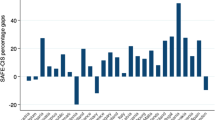Abstract
The paper presents a new sectoral taxonomy, which classifies industries according to the opportunity and cost of experimentation. Econometric tests show for a sample of 24 countries that in the 1990s ‘entrepreneurial’ industries with a mutable and growing firm population experienced the highest growth in terms of value added and employment, but also the lowest growth of labour productivity. ‘Entrepreneurial’ industries generally earned a better profit-ratio than ‘routinised’ industries with an inertial population. The results are consistent with entrepreneurial theories of market competition, which suggest that entry follows profit opportunities but does not deplete them.
Similar content being viewed by others
References
Acs Zoltan, J., David, B., & Audretsch, D. B. (Eds.) (2003). Handbook of entrepreneurship research. Boston: Kluwer.
Anderberg, M. R. (1973). Cluster analysis for applications. New York: Academic Press.
Audretsch, D. B. (1995). Innovation and industry evolution. Cambridge MA: MIT Press.
Audretsch, D. B. (1991). New-firm survival and the technological regime. The Review of Economics and Statistics, 73(3), 441–450.
Audretsch, D. B., & Fritsch, M. (2002). Growth regimes over time and space. Regional Studies, 36(2), 113–124.
Bain, J. (1956). Barriers to new competition. Cambridge MA: Harvard University Press.
Baltagi, B. H. (2001). Econometric analysis of panel data (2nd ed.). Chichester, New York: Wiley & Sons.
Barro, R. J., & Sala-i-Martin, X. (1995). Economic growth. New York: McGraw Hill.
Bartelsman, E., Scarpetta, S., & Schivardi, F. (2003). Comparative analysis of firm demographics and survival: Micro-level evidence for the OECD countries. Economics Department, Working Papers No. 348, Paris: OECD.
Baumol, W. J., Panzar, J., & Willig, R. (1982) Contestable markets and the theory of industry structure. New York: Harcourt Brace Jovanovich.
Carree, M., & Thurik, R. (1996). Entry and exit in retailing: Incentives, barriers, displacement and replacement. Review of Industrial Organization, 11(2), 155–172.
Dunne, T., & Roberts, M. J. (1991). Variation in producer turnover across US manufacturing industries. In P. A. Geroski & J. Schwalbach (Eds.), Entry and market contestability: An international comparison (pp. 187–203). Oxford.
Geroski, P. (1995). What do we know about entry? International Journal of Industrial Organization, 13(4), 421–440.
Geroski, P. (1994). Market structure, corporate performance, and innovative activity. Oxford: Oxford University Press.
Gordon, A. D. (1999). Classification (2nd ed.). Boca Raton: Chapman & Hall.
Haltiwanger, J. (2000). Aggregate growth, what have we learned from microeconomic evidence? ECO/WKP (2000) 40, Paris: OECD.
Jovanovic, B. (1982). Selection and the evolution of industry. Econometrica, 50(3), 649–670.
Kaufmann, L., & Peter, J. R. (1990). Finding groups in data. An introduction to cluster analysis. New York: Wiley.
Kirzner, I. M. (1997). Entrepreneurial discovery and the competitive market process: An austrian approach. Journal of Economic Literature, 35(1), 60–85.
Klepper, S. (1996). Entry, Exit, Growth, and Innovation over the Product Life Cycle. American Economic Review 86(3), 562–583.
Malerba, F., & Orsenigo, L. (1993). Technological regimes and firm behavior. Industrial and Corporate Change, 2(1), 45–71.
Mansfield, E. (1962). Gibrat’s law, innovation, and the growth of firms. American Economic Review, 52, 1023–1051.
March, J. G. (1999). The Pursuit of Organizational Intelligence. Oxford: Blackwell.
Metcalfe, S. J. (1998). Evolutionary economics and creative destruction. London: Routledge.
Nelson, R., & Winter, S. (1982). An Evolutionary Theory of Economic Change. Cambridge MA: Belknap Press.
Peneder, M. (2005). Creating industry classifications by statistical cluster analysis. Estudios de Economica Aplicada, 23(2), 451–463.
Peneder, M. (2003). Industry classifications. Aim, scope and techniques. Journal of Industry Competition and Trade 3(1–2), 109–130.
Peneder, M. (2001). Entrepreneurial competition and industrial location. Cheltenham UK: Edgar Elgar.
Shane, S. (2004). A general theory of entrepreneurship. Cheltenham UK: Edward Elgar.
Sharma, S. (1996). Applied multivariate techniques. New York: Wiley & Sons.
Scherer, F. M. (1965). Firm size, market structure, opportunity, and the output of patented inventions. American Economic Review, 55, 1097–1125.
Schmalensee, R. (1986). Inter-industry studies of structure and performance. In R. Schmalensee & R. Willig (Eds.), Handbook of industrial organization. North Holland: Amsterdam.
Schumpeter, J. A. (1942). Capitalism, socialisms and democracy. New York: Harper.
Schumpeter, J. A. (1911). Theorie der wirtschaftlichen Entwicklung (4th ed.). Berlin: Duncker & Humblot.
Schultz, T. (1975). The value of the ability to deal with disequilibria. Journal of Economic Literature, 13(3), 827–846.
Slade, M. (2004). Models of firm profitability. International Journal of Industrial Organisation, 22(3), 289–308.
Sleuwaegen, L., & Dehandschutter, W. (1991). Entry and exit in Belgian manufacturing. In P. A. Geroski &␣J.␣Schwalbach (Eds.), Entry and market contestability: An international comparison (pp. 111–120). Oxford.
Solow, R. M. (2000). Growth theory. An exposition (2nd ed.). Oxford: Oxford University Press.
Sutton, J. (1998). Technology and market structure. Cambridge Mass: MIT Press.
Sutton, J. (1991). Sunk costs and market structure price competition, advertising, and the evolution of concentration. Cambridge Mass: MIT Press.
Venkataraman, S. (1997). The distinctive domain of entrepreneurship research. In J. Katz & R. Brockhaus (Eds.), Advances in entrepreneurship, firm emergence, and growth (Vol. 3, pp. 119–138). Greenwich: JAI Press.
Winter, S. (1984). schumpeterian competition in alternative technological regimes. Journal of Economic Behavior and Organization, 5(3–4), 287–320.
Acknowledgements
This paper has benefited from the technical assistance of Eva Sokoll and Traude Novak as well as comments and suggestions by Karl Aiginger, Martin Falk, Werner Hölzl, Serguei Kaniovski, Gunther Tichy, an anonymous referee, the Associate Editor and participants in the conferences of the European Association for Research in Industrial Economics (EARIE) 2006, the International Schumpeter Society (ISS) 2006, as well as the Industrial Organisation Society (IOS) 2005. The author retains the sole responsibility for any errors, or omissions.
Author information
Authors and Affiliations
Corresponding author
Rights and permissions
About this article
Cite this article
Peneder, M.R. Firm entry and turnover: the nexus with profitability and growth. Small Bus Econ 30, 327–344 (2008). https://doi.org/10.1007/s11187-007-9048-z
Received:
Accepted:
Published:
Issue Date:
DOI: https://doi.org/10.1007/s11187-007-9048-z




